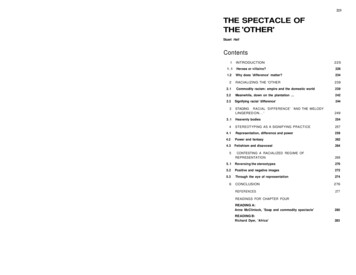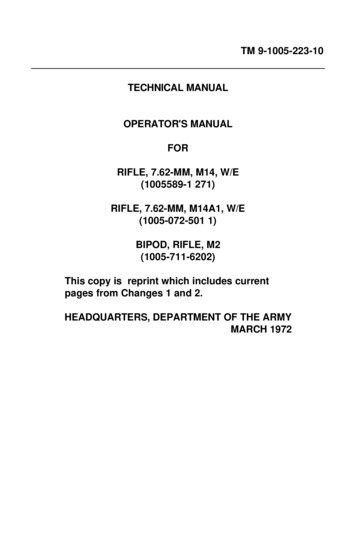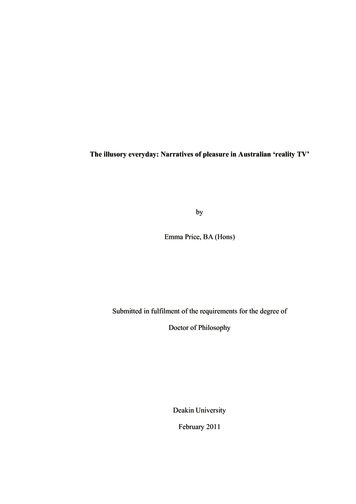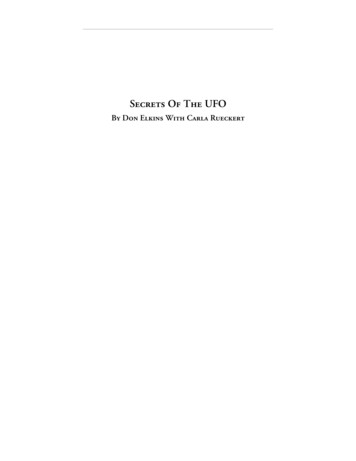
Transcription
223THE SPECTACLE OFTHE 'OTHER'Stuart HallContentsINTRODUCTION2251.11Heroes or villains?2261.2Why does 'difference' matter?234RACIALIZING THE 'OTHER23922.1Commodity racism: empire and the domestic world2392.2Meanwhile, down on the plantation .2422.3Signifying racial 'difference'244STAGING RACIAL 'DIFFERENCE' 'AND THE MELODYLINGERED O N . . . '249Heavenly bodies25433.144.1STEREOTYPING AS A SIGNIFYING PRACTICE257Representation, difference and power2594.2Power and fantasy2624.3Fetishism and disavowal264CONTESTING A RACIALIZED REGIME OFREPRESENTATION2695.1Reversing the stereotypes2705.2Positive and negative images2725.3Through the eye of NGS FOR CHAPTER FOURREADING A:Anne McClintock, 'Soap and commodity spectacle'280READING B:Richard Dyer, 'Africa'283
CHAPTER -1 THE SPECTACLE OF THE 'OTHER1224READING C:Sander Gilman, The deep structure of stereotypes'READING D:Kobena Mercer, 'Reading racial fetishism'I225Introduction284285How do we represent people and places which are significantly different fromus? Why is 'difference' so compelling a theme, so contested an area ofrepresentation? What is the secret fascination of 'otherness', and why ispopular representation so frequently drawn to it? What are the typical formsand representational practices which are used to represent 'difference' inpopular culture today, and where did these popular figures and stereotypescome from? These are some of the questions about representation which weset out to address in this chapter. We will pay particular attention to thoserepresentational practices which we call 'stereotyping'. By the end we hopeyou will understand better how what we call 'the spectacle of the "Other"'works, and be able to apply the ideas discussed and the sorts of analysisundertaken here to the mass of related materials in contemporary popularculture — for example, advertising which uses black models, newspaperreports about immigration, racial attacks or urban crime, and films andmagazines which deal with 'race' and ethnicity as significant themes.The theme of 'representing difference' is picked up directly from theprevious chapter, where Henrietta Lidchi looked at how 'other cultures' aregiven meaning by the discourses and practices of exhibition in ethnographicmuseums of 'the West'. Chapter 3 focused on the 'poetics' and the 'polities' ofexhibiting — both how other cultures are made to signify through thediscourses of exhibition (poetics) and how these practices are inscribed byrelations of power (politics) — especially those which prevail between thepeople who are represented and the cultures and institutions doing therepresenting. Many of the same concerns arise again in this chapter.However, here, racial and ethnic difference is foregrounded. You should bearin mind, however, that what is said about racial difference could equally beapplied in many instances to other dimensions of difference, such as gender,sexuality, class and disability.Our focus here is the variety of images which are on display in popularculture and the mass media. Some are commercial advertising images andmagazine illustrations which use racial stereotypes, dating from the period ofslavery or from the popular imperialism of the late nineteenth century.However, Chapter 4 brings the story up to the present. Indeed, it begins withimages from the competitive world of modern athletics. The question whichthis comparison across time poses is: have the repertoires of representationaround 'difference' and 'otherness' changed or do earlier traces remain intactin contemporary society?The chapter looks in depth at theories about the representational practiceknown as 'stereotyping'. However, the theoretical discussion is threadedthrough the examples, rather than being introduced for its own sake. Thechapter ends by considering a number of different strategies designed tointervene in the field of representation, to contest 'negative' images andtransform representational practices around 'race' in a more 'positive'
226REPRESENTATION: CULTURAL REPRESENTATIONS AND SIGNIFYING PRACTICESCHAPT LR 4THE SPECTACLE OF THE 'OTHER1direction. It poses the question of whether there can be an effective 'politicsof representation'.Once again, then, visual representation takes centre stage. The chaptersustains the overall theme by continuing our exploration of representation asa concept and a practice - the key first 'moment' in the cultural circuit. Ouraim is to deepen our understanding of what representation is and how itworks. Representation is a complex business and, especially when dealingwith 'difference', it engages feelings, attitudes and emotions and it mobilizesfears and anxieties in the viewer, at deeper levels than we can explain in asimple, common-sense way. This is why we need theories - to deepen ouranalysis. The chapter, then, builds on what we have already learned aboutrepresentation as a signifying practice, and continues to develop criticalconcepts to explain its operations.I.IHeroes or villains?Look, first, at Figure 4.1. It is a picture of the men's 100 metres final at the1988 Olympics which appeared on the cover of the Olympics Special of theSunday Times colour magazine (9 October 1988). It shows the black Canadiansprinter, Ben Johnson, winning in record time from Carl Lewis and LinfordChristie: five superb athletes in action, at the peak of their physical prowess.All of them men and - perhaps, now, you will notice consciously for the firsttime - all of them black!How do you 'read' the picture — what is it saying? In Barthes' terms, whatis its 'myth' - its underlying message?One possible message relates to their racial identity. These athletes are allfrom a racially-defined group — one often discriminated against preciselyon the grounds of their 'race' and colour, whom we are more accustomedto see depicted in the news as the victims or 'losers' in terms ofachievement. Yet here they are, winning!In terms of difference, then — a positive message: a triumphant moment, acause for celebration. Why, then, does the caption say, 'Heroes andvillains'? Who do you think is the hero, who the villain?Even if you don't follow athletics, the answer isn't difficult to discover.Ostensibly about the Olympics, the photo is in fact a trailer for the magazine'slead story about the growing menace of drug-taking in international athletics- what inside is called 'The Chemical Olympics'. Ben Johnson, you mayrecall, was found to have taken drugs to enhance his performance. He wasdisqualified, the gold medal being awarded to Carl Lewis, and Johnson wasexpelled from world athletics in disgrace. The story suggests that all athletes- black or white - are potentially 'heroes' and 'villains'. But in this image,Ben Johnson personifies this split in a particular way. He is both 'hero' andFIGURE 4.1 'Heroes and Villains', cover of The Sunday Times Magazine, 9 October 1988.227
228REPRESENTATION: CULTURAL REPRESENTATIONS AND SIGNIFYING PRACTICESCHAPTER 4 THE SPECTACLE OF THE 'OTHER''villain'. He encapsulates the extreme alternatives of heroism and villainy inworld athletics in one black body.FIGURE 4.2 Linford Christie, holding a UnionJack, having won the men's 100 metres Olympic goldmedal, Barcelona 1992.There are several points to make about the way the representation of 'race'and 'otherness' is working in this photo. First, if you think back to Chapters 1and 3, you will remember the work of Barthes on the idea of 'myth'. Thisphoto, too, functions at the level of 'myth'. There is a literal, denotative levelof meaning — this is a picture of the 100 metres final and the figure in front isBen Johnson. Then there is the more connotative or thematic meaning — thedrug story. And within that, there is the sub-theme of 'race' and 'difference'.Already, this tells us something important about how 'myth' works. Theimage is a very powerful one, as visual images often are. But its meaning ishighly ambiguous. It can carry more than one meaning. If you didn't knowthe context, you might be tempted to read this as a moment of unqualifiedtriumph. And you wouldn't be 'wrong1 since this, too, is a perfectlyacceptable meaning to take from the image. But, as the caption suggests, it isnot produced here as an image of 'unqualified triumph'. So, the same photocan carry several, quite different, sometimes diametrically oppositemeanings. It can be a picture of disgrace or of triumph, or both. Manymeanings, we might say, are potential within the photo. But there is no one,true meaning. Meaning 'floats'. It cannot be finally fixed. However,attempting to 'fix' it is the work of a representational practice, whichintervenes in the many potential meanings of an image in an attempt toprivilege one.So, rather than a 'right' or 'wrong' meaning, what we need to ask is, 'Which ofthe many meanings in this image does the magazine mean to privilege?'Which is the preferred meaning? Ben Johnson is the key element herebecause he is both an amazing athlete, winner and record-breaker, and theathlete who was publicly disgraced because of drug-taking. So, as it turns out,the preferred meaning is both 'heroism* and 'villainy'. It wants to saysomething paradoxical like, 'In the moment of the hero's triumph, there isalso villainy and moral defeat.' In part, we know this is the preferred meaningwhich the magazine wants the photo to convey because this is the meaningwhich is singled out in the caption: HEROES AND VILLAINS. RolandBarthes (1977) argues that, frequently, it is the caption which selects one outof the many possible meanings from the image, and anchors it with words.The 'meaning' of the photograph, then, does not lie exclusively in the image,but in the conjunction of image and text. Two discourses - the discourse ofwritten language and the discourse of photography - are required to produceand 'fix' the meaning (see Hall, 1972).As we have suggested, this photo can also be 'read', connotatively, in terms ofwhat it has to 'say' about 'race'. Here, the message could be - black peopleshown being good at something, winning at last! But in the light of the'preferred meaning', hasn't the meaning with respect to 'race' and 'otherness'changed as well? Isn't it more something like, 'even when black people areshown at the summit of their achievement, they often fail to carry it off? This229having-it-both-ways is important because, as Ihope to show you, people who are in any waysignificantly different from the majority —'them' rather than 'us' - are frequentlyexposed to this binary form of representation.They seem to be represented through sharplyopposed, polarized, binary extremes - good/bad, civilized/primitive, ugly/excessivelyattractive, ange-and-exotic. Andthey are often required to be both things at thesame time] We will return to these splitfigures or 'tropes' of representation in amoment.preferredmeaningBut first, let us look at another, similar newsphoto, this time from another record-breaking100 metres final. Linford Christie, subsequently captain of the BritishOlympics squad, at the peak of his career, having just won the race of alifetime. The picture captures his elation, at the moment of his lap of honour.He is holding the Union Jack. In the light of the earlier discussion, how do you'read' this photograph (Figure 4.2)? What is it 'saying' about 'race' and culturalidentity?Which of the following statements, in your view, comes closest toexpressing the 'message' of the image?(a) This is the greatest moment of my life! A triumph for me, LinfordChristie.'(b) This is a moment of triumph for me and a celebration for blackpeople everywhere!'(c) This is a moment of triumph and celebration for the British Olympicteam and the British people!'(d) This is a moment of triumph and celebration for black people andthe British Olympic team. It shows that you can be "Black" and"British"!'There is, of course, no 'right' or 'wrong' answer to the question. The imagecarries many meanings, all equally plausible. What is important is the fact thatthis image both shows an event (denotation) and carries a 'message' ormeaning (connotation) — Barthes would call it a 'meta-message' or myth —about 'race', colour and 'otherness'. We can't help reading images of this kind
230CHAPTER 4 THE SPECTACLE OF THE 'OTHER1REPRESENTATION: CULTURAL REPRESENTATIONS AND SIGNIFYING PRACTICESas 'saying something', not just about the people or the occasion, but abouttheir 'otherness', their 'difference'. 'Difference' has been marked. How it isthen interpreted is a constant and recurring preoccupation in therepresentation of people who are racially and ethnically different from themajority population. Difference signifies. It 'speaks'.In a later interview, discussing his forthcoming retirement from internationalsport, Christie commented on the question of his cultural identity - where hefeels he 'belongs' (The Sunday Independent, 11 November 1995). He has veryfond memories of Jamaica, he said, where he was born and lived until the ageof 7. But 'I've lived here [in the UK] for 28 [years]. I can't be anything otherthan British' (p. 18). Of course, it isn't as simple as that. Christie is perfectlywell aware that most definitions of 'Britishness' assume that the person whobelongs is 'white'. It is much harder for black people, wherever they wereborn, to be accepted as 'British'. In 1995, the cricket magazine, Wisden, hadto pay libel damages to black athletes for saying that they couldn't beexpected to display the same loyalty and commitment to winning for Englandbecause they are black. So Christie knows that every image is also being'read' in terms of this broader question of cultural belongingness anddifference.Indeed, he made his remarks in the context of the negative publicity to whichhe has been exposed in some sections of the British tabloid press, a good dealof which hinges on a vulgar, unstated but widely recognized 'joke' at hisexpense: namely that the tight-fitting Lycra shorts which he wears are said toreveal the size and shape of his genitals. This was the detail on which TheSun focused on the morning after he won an Olympic gold medal. Christiehas been subject to continuous teasing in the tabloid press about theprominence and size of his 'lunchbox' - a euphemism which some havetaken so literally that, he revealed, he has been approached by a firm wantingto market its lunchboxes around his image! Linford Christie has observedabout these innuendoes: 'I felt humiliated . My first instinct was that it wasracist. There we are, stereotyping a black man. I can take a good joke. But ithappened the day after I won the greatest accolade an athlete can win . Idon't want to go through life being known for what I've got in my shorts. I'm aserious person ." (p. 15).231What, for example, did the French writer, Michael Cournot, whom Fanonquotes, mean when he wrote that 'Four Negroes with their penisesexposed would fill a cathedral'? (Fanon, 1986/1952, p. 169). What is therelationship of these fantasies of sexuality to 'race' and ethnicity in therepresentation of 'otherness' and 'difference'?We have now introduced another dimension into the representation of'difference' - adding sexuality and gender to 'race', ethnicity and colour. Ofcourse, it is well established that sport is one of the few areas where blackpeople have had outstanding success. It seems natural that images of blackpeople drawn from sport should emphasize the body, which is theinstrument of athletic skill and achievement. It is difficult, however, to haveimages of bodies in action, at the peak of their physical perfection, withoutthose images also, in some way, carrying 'messages' about gender and aboutsexuality. Where black athletes are concerned, what are these messagesabout?ACTIVITY 4Look, for example, at the picture from the Sunday Times 1988 OlympicSpecial, of the black American sprinter, Florence Griffith-Joyner, whowon three gold medals at Seoul (Figure 4.3). Can you 'read' this photowithout getting some 'messages' about 'race', gender and sexuality — evenif what the meanings are remain ambiguous? Is there any doubt that thephoto is 'signifying' along all three dimensions? In representation, onesort of difference seems to attract others - adding up to a 'spectacle' ofACTIVITY 3What is going on here? Is this just a joke in bad taste, or does it have adeeper meaning? What do sexuality and gender have to do with images ofblack men and women? Why did the black French writer fromMartinique, Frantz Fanon, say that white people seem to be obsessedwith the sexuality of black people?It is the subject of a widespread fantasy, Fanon says, which fixates theblack man at the level of the genitals. 'One is no longer aware of theNegro, but only of a penis; the Negro is eclipsed. He is turned into apenis' (Fanon, 1986/1952, p. 170).FIGURE 4.3 Florence Griffith-Joyner.
232REPRESENTATION: CULTURAL REPRESENTATIONS AND SIGNIFYING PRACTICESCHAPTER 4 THE SPECTACLE OF THE 'OTHER1otherness. If you're not convinced, you might think of this in the contextof the remark by 'Flo-Jo's' husband, Al Joyner, quoted in the text next tothe photo: 'Someone Says My Wife Looked Like A Man'. Or consider thephoto (which was reproduced on the following page of the article) of AlJoyner's sister, Jackie Joyner-Kersee, who also won a gold medal andbroke world records at Seoul in the heptathlon, preparing to throw ajavelin, accompanied by text quoting another observation by Al Joyner:'Somebody Says My Sister Looked Like A Gorilla'(Figure 4.4).FIGURE 4.4 Jackie Joyner-Kersee.There is an additional point to be made about these photographs of blackathletes in the press. They gain in meaning when they are read in context,against or in connection with one another. This is another way of saying thatimages do not carry meaning or 'signify' on their own. They accumulatemeanings, or play off their meanings against one another, across a variety oftexts and media. Each image carries its own, specific meaning. But at thebroader level of how 'difference' and 'otherness' is being represented in aparticular culture at any one moment, we can see similar representationalpractices and figures being repeated, with variations, from one text or site ofrepresentation to another. This accumulation of meanings across differenttexts, where one image refers to another, or has its meaning altered by being'read' in the context of other images, is called inter-textuality. We maydescribe the whole repertoire of imagery and visual effects through which'difference' is represented at any one historical moment as a regime ofrepresentation; this is very similar to what, in Chapter 2, Peter Hamiltonreferred to as a representational paradigm.233An interesting example of inter-textuality, where the image depends for itsmeaning on being 'read' in relation to a number of other, similar images, canbe found in Figure 4.5. This is Carl Lewis, one of the sprinters you saw inFigure 4.1, taken from a Pirelli advertisement. At first glance, the imagesummons up echoes of all the previous images we have been looking at —superbly-honed athletic bodies, tensed in action, super-men and superwomen. But here the meaning is differently inflected. Pirelli is a tyre firmwith a reputation for producing calendars with pictures of beautiful women,scantily clad, in provocative poses - the prototypical 'pin-up'. In which ofthese two contexts should we 'read' the Carl Lewis image? One clue lies inthe fact that, though Lewis is male, in the ad he is wearing elegant, highheeled red shoes!FIGURE 4.5Carl Lewis,photographed fora Pirelliadvertisement.ACTIVITY 5What is this image saying? What is its message? How does it 'say' it?This image works by the marking of 'difference'. The conventionalidentification of Lewis with black male athletes and with a sort of 'supermasculinity' is disturbed and undercut by the invocation of his 'femininity' and what marks this is the signifier of the red shoes. The sexual and racial'message' is rendered ambiguous. The super-male black athlete may not be allhe seems. The ambiguity is amplified when we compare this image with allthe other images - the stereotypes we are accustomed to see - of blackathletes in the press. Its meaning is inter-textual - i.e. it requires to be read'against the grain'.
234REPRESENTATION: CULTURAL REPRESENTATIONS AND SIGNIFYING PRACTICESDoes this photo reinforce or subvert the stereotype? Some people say it'sjust an advertiser's joke. Some argue that Carl Lewis has allowed himselfto be exploited by a big corporate advertiser. Others argue that hedeliberately set out to challenge and contest the traditional image ofblack masculinity. What do you think?In the light of these examples, we can rephrase our original questions moreprecisely. Why is 'otherness' so compelling an object of representation? Whatdoes the marking of racial difference tell us about representation as apractice? Through which representational practices are racial and ethnicdifference and 'otherness' signified? What are the 'discursive formations', therepertoires or regimes of representation, on which the media are drawingwhen they represent 'difference'? Why is one dimension of difference - e.g.'race' - crossed by other dimensions, such as sexuality, gender and class?And how is the representation of 'difference' linked with questions of power?1.2 Why does 'difference' matter?Before we analyse any more examples, let us examine some of the underlyingissues posed by our first question. Why does 'difference' matter — how can weexplain this fascination with 'otherness'? What theoretical arguments can wedraw on to help us unpack this question?Questions of 'difference' have come to the fore in cultural studies in recentdecades and been addressed in different ways by different disciplines. In thissection, we briefly consider four such theoretical accounts. As we discussthem, think back to the examples we have just analysed. In each, we start byshowing how important 'difference' is - by considering what is said to be itspositive aspect. But we follow this by some of the more negative aspects of'difference'. Putting these two together suggests why 'difference' is bothnecessary and dangerous.1 The first account comes from linguistics - from the sort of approachassociated with Saussure and the use of language as a model of how cultureworks, which was discussed in Chapter 1. The main argument advanced hereis that 'difference' matters because it is essential to meaning; without it,meaning could not exist. You may remember from Chapter 1 the example ofwhite/black. We know what black means, Saussure argued, not because thereis some essence of 'blackness' but because we can contrast it with its opposite- white. Meaning, he argued, is relational. It is the 'difference'between whiteand black which signifies, which carries meaning. Carl Lewis in that photocan represent 'femininity' or the 'feminine' side of masculinity because hecan mark his 'difference' from the traditional stereotypes of blackmasculinity by using the red shoes as a signifies This principle holds forbroader concepts too. We know what it is to be 'British', not only because ofcertain national characteristics, but also because we can mark its 'difference'CHAPTER 4 THE SPECTACLE OF THE 'OTHER'235from its 'others' - 'Britishness' is not-French, not-American, not-German,not-Pakistani, not-Jamaican and so on. This enables Linford Christie tosignify his 'Britishness' (by the flag) while contesting (by his black skin) that'Britishness' must always mean 'whiteness'. Again, 'difference' signifies. Itcarries a message.So meaning depends on the difference between opposites. However, whenwe discussed this argument in Chapter 1, we recognized that, though binaryoppositions - white/black, day/night, masculine/feminine, British/alien have the great value of capturing the diversity of the world within theireither/or extremes, they are also a rather crude and reductionist way ofestablishing meaning. For example, in so-called black-and-whitephotography, there is actually no pure 'black' or 'white', only varying shadesof grey. 'Black' shades imperceptibly into 'white', just as men have both'masculine' and 'feminine' sides to their nature; and Linford Christiecertainly wants to affirm the possibility of being both 'black' and 'British'though the normal definition of 'Britishness' assumes that it is white.Thus, while we do not seem able to do without them, binary oppositions arealso open to the charge of being reductionist and over-simplified swallowing up all distinctions in their rather rigid two-part structure. What ismore, as the philosopher Jacques Derrida has argued, there are very fewneutral binary oppositions. One pole of the binary, he argues, is usually thedominant one, the one which includes the other within its field ofoperations. There is always a relation of power between the poles of a binaryopposition (Derrida, 1974). We should really write, white/black, men/women, masculine/feminine, upper class/lower class, British/alien tocapture this power dimension in discourse.2 The second explanation also comes from theories of language, but from asomewhat different school to that represented by Saussure. The argumenthere is that we need 'difference' because we can only construct meaningthrough a dialogue with the 'Other'. The great Russian linguist and critic,Mikhail Bakhtin, who fell foul of the Stalinist regime in the 1940s, studiedlanguage, not (as the Saussureans did) as an objective system, but in terms ofhow meaning is sustained in the dialogue between two or more speakers.Meaning, Bakhtin argued, does not belong to any one speaker. It arises in thegive-and-take between different speakers. 'The word in language is halfsomeone else's. It becomes 'one's own' only when . the speaker appropriatesthe word, adapting it to his own semantic expressive intention. Prior to this. the word does not exist in a neutral or impersonal language . rather itexists in other people's mouths, serving other people's intentions: it is fromthere that one must take the word and make it one's own' (Bakhtin, 1981[1935], pp. 293-4). Bakhtin and his collaborator, Volosinov, believed that thisenabled us to enter into a struggle over meaning, breaking one set ofassociations and giving words a new inflection. Meaning, Bakhtin argued, isestablished through dialogue - it is fundamentally dialogic. Everything wesay and mean is modified by the interaction and interplay with another
236REPRESENTATION: CULTURAL REPRESENTATIONS AND SIGNIFYING PRACTICESperson. Meaning arises through the 'difference' between the participants inany dialogue. The 'Other', in short, is essential to meaning.This is the positive side of Bakhtin's theory. The negative side is, of course,that therefore meaning cannot be fixed and that one group can never becompletely in charge of meaning. What it means to be 'British' or 'Russian' or'Jamaican' cannot be entirely controlled by the British, Russians orJamaicans, but is always up for grabs, always being negotiated, in thedialogue between these national cultures and their 'others'. Thus it has beenargued that you cannot know what it meant to be 'British' in the nineteenthcentury until you know what the British thought of Jamaica, their prizecolony in the Caribbean, or Ireland, and more disconcertingly, what theJamaicans or the Irish thought of them . (C. Hall, 1994).3 The third kind of explanation is anthropological, and you have alreadymet it in du Gay, Hall et al. (1997). The argument here is that culturedepends on giving things meaning by assigning them to different positionswithin a classificatory system. The marking of 'difference' is thus the basis ofthat symbolic order which we call culture. Mary Douglas, following theclassic work on symbolic systems by the French sociologist, Emile Durkheim,and the later studies of mythology by the French anthropologist, Claude LeViStrauss, argues that social groups impose meaning on their world by orderingand organizing things into classificatory systems (Douglas, 1966). Binaryoppositions are crucial for all classification, because one must establish aclear difference between things in order to classify them. Faced with differentkinds of food, Levi-Strauss argued (1979), one way of giving them meaning isto start by dividing them into two groups - those which are eaten 'raw' andthose eaten 'cooked'. Of course, you can also classify food into 'vegetables'and 'fruit'; or into those which are eaten as 'starters' and those which areeaten as 'desserts'; or those which are served up at dinner and those whichare eaten at a sacred feast or the communion table. Here, again, 'difference' isfundamental to cultural meaning.However, it can also give rise to negative feelings and practices. MaryDouglas argues that what really disturbs cultural order is when things turn upin the wrong category; or when things fail to fit any category - such as asubstance like mercury, which is a metal but also a liquid, or a social grouplike mixed-race mulattoes who are neither 'white' nor 'black' but floatambiguously in some unstable, dangerous, hybrid zone of indeterminacyin-between (Stallybrass and White, 1986). Stable cultures require things tostay in their appointed place. Symbolic boundaries keep the categories'pure', giving cultures their unique meaning and identity. What unsettlesculture is 'matter out of place' - the breaking of our unwritten rules andcodes. Dirt in the garden is fine, but dirt in one's bedroom is 'matter out ofplace' - a sign of pollution, of symbolic boundaries being transgressed, oftaboos broken. What we do with 'matter out of place' is to sweep it up, throwit out, restore the place to order, bring back the normal state of affairs. Theretreat of many cultures towards 'closure' against foreigners, intruders,aliens and 'others' is part of the same
something paradoxical like, 'In the moment of the hero's triumph, there is also villainy and moral defeat.' In part, we know this is the preferred meaning which the magazine wants the photo to con










